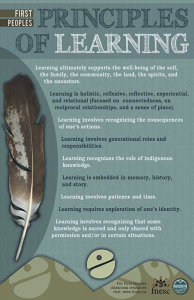First Peoples Principles of Learning
In my UNBC Bachelor of Education practicum I was able to experience how the First Peoples Principles of Learning can bring a lesson together and make the content, big ideas, core competencies, and curricular competencies make sense together.
At first, it was difficult for me to articulate how the First Peoples Principles of Learning fit into the lessons I was trying to plan, but as I developed familiarity with the process of lesson planning and became more confident in my understanding of each of the First Peoples Principles of Learning, I began to see the difference between fitting them in and truly embedding the ideas into lessons. Initially, I struggled with “Learning Involves Generational Roles and Responsibilities” (First Nations Education Steering Committee, n.d.), but the learning from that effort was incredible.
It took a while for me to realize that generational meant more than just ancestral, and although it signifies that too, Jo Chrona explains more clearly that it means “The responsibility for teaching belongs to everyone in the community. As people develop their skills and knowledge in particular areas, it is expected that they will in turn teach others” (2019). So everyone is responsible for teaching and learning. If a person does not teach what they know, others will be bereft of that knowledge. If another person is not willing to learn, they will not have knowledge they may need, but worse, they will never be able to pass that knowledge on to others. When described this way, learning becomes a natural, cyclical process, similar to many others found in nature.
The picture to the right, titled Saskatoon Berry Plant, shows the learning model I created to explain how I feel it all fits together. The roots represent everything that informs teaching and learning, like curriculum, traditions, theories, teaching methods and learning styles. The stem stands for the formal (therefore capitalized) practice of Teaching and Learning. The Leaves signify a community of Elders, Knowledge-Keepers, teachers, and peers that nourish the plant of education. Flowers are Learners, who will develop into fruit under the right conditions. Berries are accomplished learners who can help and support others, as well as exemplify the ideal outcome of the education process. Seeds represent the knowledge and ideas that develop as a result of learning, and from the seeds, new plants and new learning can grow.
I was able to use this experience of digging deeper into one of the First Peoples Principles of Learning to inform how I approached embedding them into my practicum lessons. For example, I could see how ideas about permission, copyright, and plagiarism are informed by “Learning involves recognizing that some knowledge is sacred and only shared with permission and/or in certain situations” (First Nations Education Steering Committee, n.d.) and once I explained this connection to my students, their understandings grew, as well.
Now, I view First Peoples Principles of Learning as the glue that holds everything together; they are the connections between every aspect of teaching and learning.
References:
Chrona, J. (2019, August 9). Learning involves generational roles and responsibilities. First Peoples Principles of Learning. https://firstpeoplesprinciplesoflearning.wordpress.com/learning-involves-generational-roles-and-responsibilities/.
First Nations Education Steering Committee. (n.d.). Learning First Peoples Classroom Resources: First Peoples Principles of Learning Poster. First Nations Education Steering Committee . http://www.fnesc.ca/learningfirstpeoples/.
A few links to start with or refer to:
First Peoples Principles of Learning – Poster – from FNESC
http://www.fnesc.ca/wp/wp-content/uploads/2015/09/PUB-LFP-POSTER-Principles-of-Learning-First-Peoples-poster-11×17.pdf
First Peoples Principles of Learning – Blog – by Jo Chrona from FNESC
https://firstpeoplesprinciplesoflearning.wordpress.com/
Learning First Peoples Classroom Resources – from FNESC
http://www.fnesc.ca/learningfirstpeoples/
